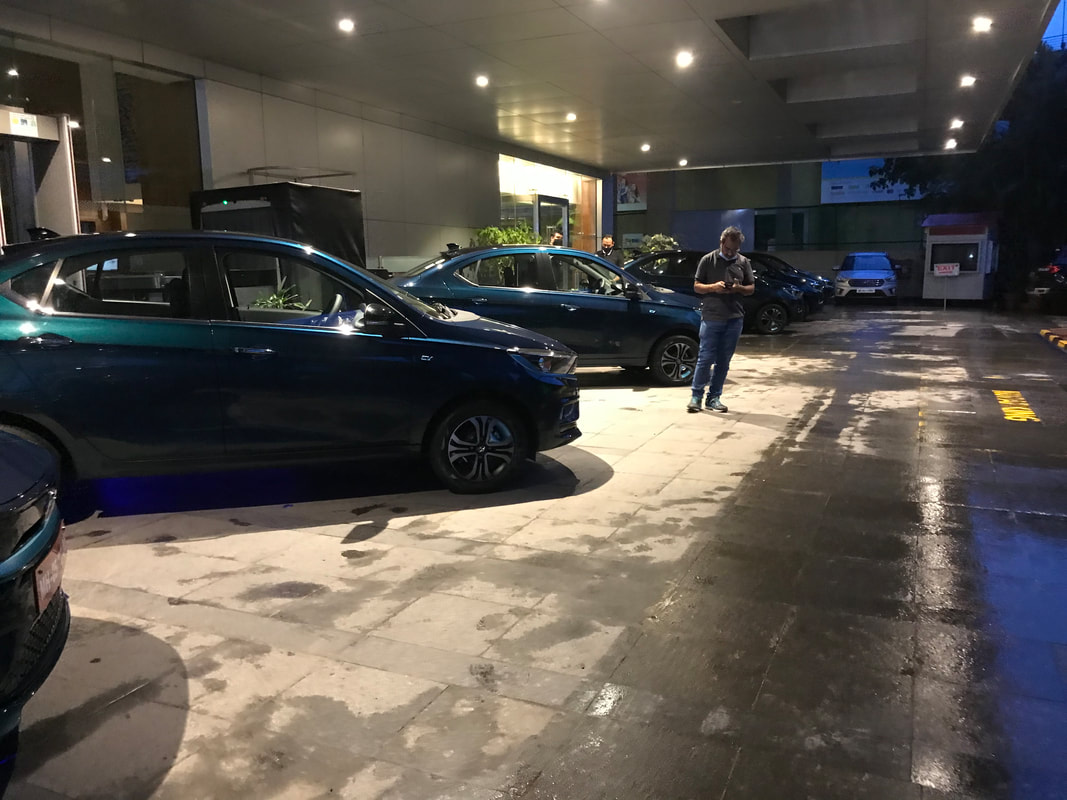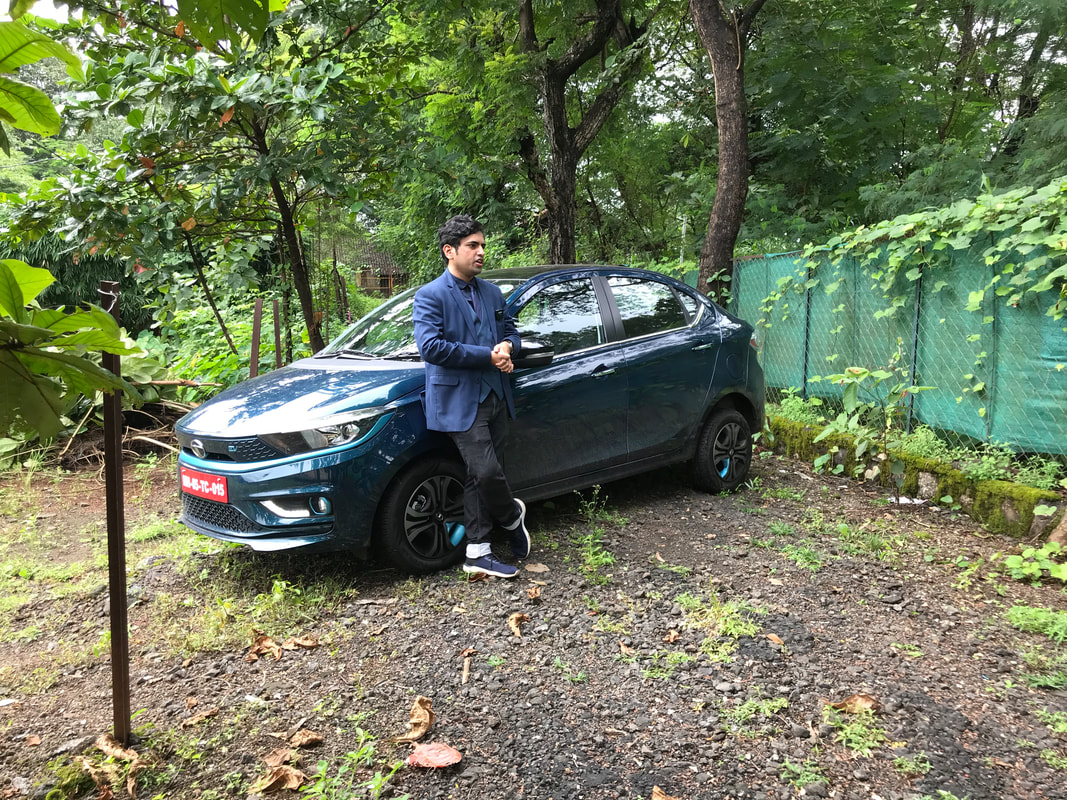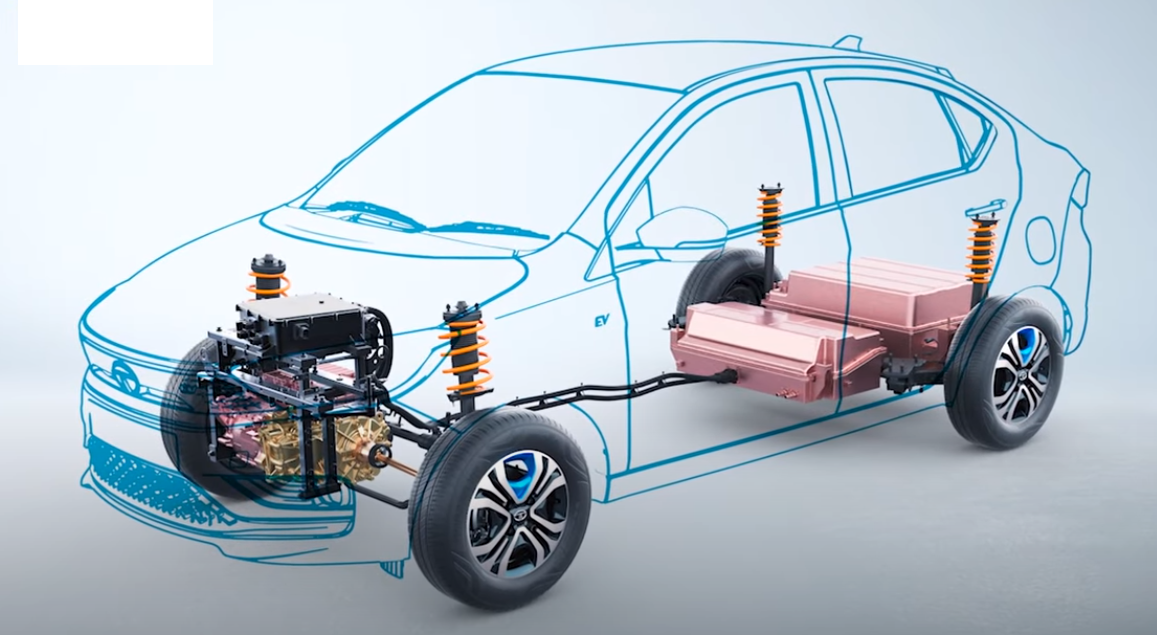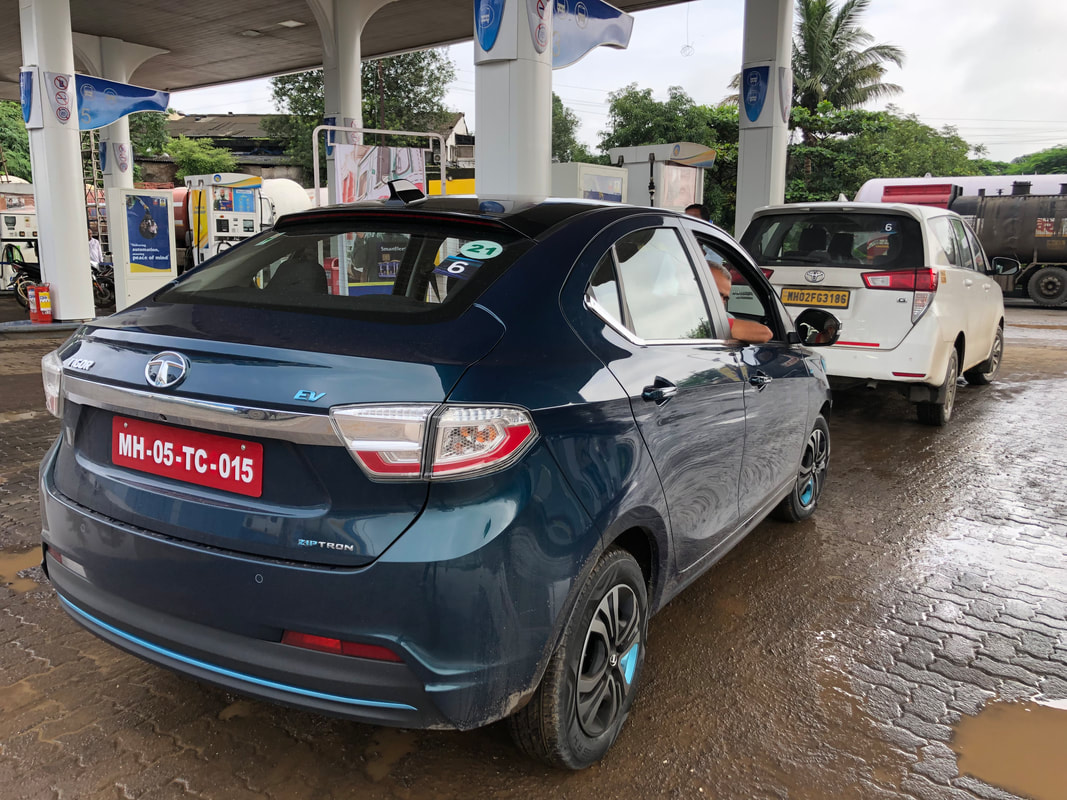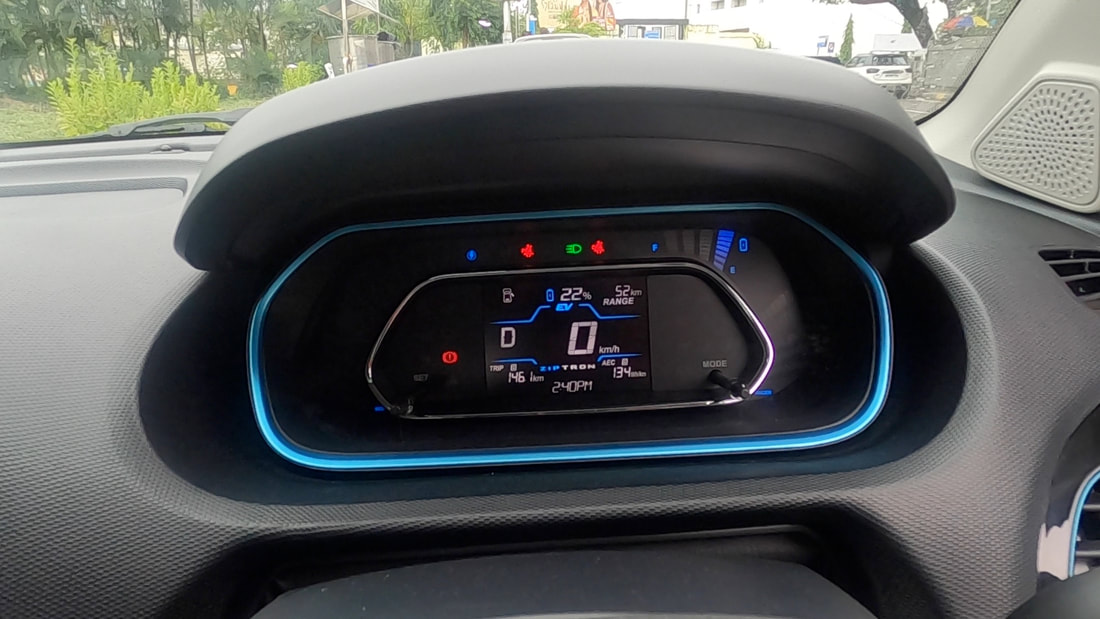By Atul Gopal
|
The PluginIndia team was invited by Tata Motors to test the all new Tata Tigor EV electric car which had an upgrade Ziptron powertrain.
The new Tigor EV with Ziptron technology, comes with GNCAP 4-star rating. Tata Motors claims that the Tigor EV comes with an ARAI-certified range of 306 kms (under standard testing conditions). But we wanted to know if if can it complete 200 km per charge on the highway? Read on! |
|
Video: Tata Tigor EV Ziptron | Range Test
We started off with Vinod ji in his Innova, at 0455 hours. We reached the four point Sheraton in Vashi in 45 minutes. After the usual documentation signatures, there was some lovely breakfast waiting for us. At 0600 hrs, gobbled down 3 sandwiches, a cake, a brownie and some pineapple juice. By this time, Abhishek and Yogesh also joined us. We were good to go.
There were 10 Tigors waiting for us. Found out from Vinod that this was the 5th day of the media invites - so about 50 publications would have finished test drives. All Tigors were in the signature teal blue EV colour. Though it looks very cool when clean, by the time we finished our drive, it had been caked with a light coating of roadside mud and had lost some of its allure. I think the second color option should have been white - they have started offering that on the Nexon EV now. Helps in reducing load on the AC.
We started with Abhishek on the wheel. There were some B rolls that got done outside Vashi railway station in the morning, when the roads had very light traffic. We then followed Google maps on to the Nashik highway via Thane. The rear seat experience was quite comforting. The leg room was adequate. Vibrations were minimal. What I liked was the absence of squeaks that I have got used to in the 6 month old Nexon EV, but then I am comparing a new Tigor with a Nexon that has already clocked 8,000 km on the odometer.
There were 10 Tigors waiting for us. Found out from Vinod that this was the 5th day of the media invites - so about 50 publications would have finished test drives. All Tigors were in the signature teal blue EV colour. Though it looks very cool when clean, by the time we finished our drive, it had been caked with a light coating of roadside mud and had lost some of its allure. I think the second color option should have been white - they have started offering that on the Nexon EV now. Helps in reducing load on the AC.
We started with Abhishek on the wheel. There were some B rolls that got done outside Vashi railway station in the morning, when the roads had very light traffic. We then followed Google maps on to the Nashik highway via Thane. The rear seat experience was quite comforting. The leg room was adequate. Vibrations were minimal. What I liked was the absence of squeaks that I have got used to in the 6 month old Nexon EV, but then I am comparing a new Tigor with a Nexon that has already clocked 8,000 km on the odometer.
Though Abhishek found the suspension a tad too stiff for his tastes, I was quite pleased with the stiffness levels. We did go through a fair amount of bad patches on the Nashik Highway. And there was no bottoming out of the suspension. And no speed breaker grazing happened. Mind you, there were four passengers in the car with some amount of luggage. And we were doing reasonably good speeds. The AC was on all the time. We ended up driving 146 km and had 21% SoC when we finished. The vehicle refused to go into sport mode when SoC drops below 25%. Here is the table of the Distance covered and SoC.
Our average consumption on the journey was 134 watt hours per km. 19.6 kWh in total, which works out to 76%. The SoC meter showed 79% consumed. We need to solve the mystery of the missing 3%! Extrapolating from our data, we can assume that the car returned a real life range of 185 km. My hope was for 200 km, since Anand Kulkarni, head of EV division at TML, had offered us some hopes for double digit wh/km. I will do my non AC light foot tests and see how many km I can squeeze out of the battery. For a typical inter city travel, one needs to end the trip with at least 20 km of range buffer. So for my Nasik trip, I need that my frugality should deliver on a range of 270 km, for me to be able to do a Pune Nasik trip without stopping at any fast charger enroute.
Abhishek had some last minute editing assignments that had come in. so he parted ways around Thane. Thanks to his early departure, I got to do a lot more driving. On the return journey Farah shifted to the Innova chase car for some external photography. We could immediately see a difference in handling, as the passenger load decreased. And the average wh per kilometre also came down from 137 to 134. I am guessing that when you have 2 passengers in city driving: AC on; speeds between 40 to 60 kmph, the range could hit 200 km. And it could touch 250 km with AC off for the intercity drives.
Our average consumption on the journey was 134 watt hours per km. 19.6 kWh in total, which works out to 76%. The SoC meter showed 79% consumed. We need to solve the mystery of the missing 3%! Extrapolating from our data, we can assume that the car returned a real life range of 185 km. My hope was for 200 km, since Anand Kulkarni, head of EV division at TML, had offered us some hopes for double digit wh/km. I will do my non AC light foot tests and see how many km I can squeeze out of the battery. For a typical inter city travel, one needs to end the trip with at least 20 km of range buffer. So for my Nasik trip, I need that my frugality should deliver on a range of 270 km, for me to be able to do a Pune Nasik trip without stopping at any fast charger enroute.
Abhishek had some last minute editing assignments that had come in. so he parted ways around Thane. Thanks to his early departure, I got to do a lot more driving. On the return journey Farah shifted to the Innova chase car for some external photography. We could immediately see a difference in handling, as the passenger load decreased. And the average wh per kilometre also came down from 137 to 134. I am guessing that when you have 2 passengers in city driving: AC on; speeds between 40 to 60 kmph, the range could hit 200 km. And it could touch 250 km with AC off for the intercity drives.
Unlike the Nexon, where the sport mode does not get used often, Tigor owners will end up using Sports mode, especially when they need to overtake and the car is loaded with a full complement of passengers. The motor is rated at a peak power of 55 kW. We can assume that for continuously rated power it will be half of that, say around 27 kW. This is adequate for most city driving situations. But it needs pepping up when weaving through highway traffic and on climbs.
What I liked particularly about the Tigor was the frugality in the cluster. I think a LED display is much better than a TFT. The brain gets hardwired to see stuff where it belongs. Most folks have favourite areas for icons on their mobile phones, which they are loath to change. Call me old school if you want to, but I want my power indicator to stay where it is. I want the regen indicator to be parked where I can expect it to be forever. I would also like the wh per km popping out information at a fixed geographical location on the console. The Tigor does not give you that luxury of changing locations for any of these, and thankfully so! I found this very confusing with both the Jaguar and to some extent the Nexon. The display is bright and has good visibility even during day time. The power and regen level indicators use large LED clusters - and are located on diametrically opposite spaces on the cluster. This is good, because you need to judge both using your peripheral vision when you are driving,
Tata Motors has done a good job in the boot. We need to understand that the underspace of the boot is now occupied by the battery pack. So there is no space for the tire under the dicky floor. In the Tigor design, the tire stands vertically on one side. This gives you enough space for stowing your travel bags. TML offers to give you a puncture kit so that you can take out the spare tire to create some extra space when you need to. One advantage I can see in this arrangement is that the vehicle weight will reduce further by 10 kg! Maybe the wh per km could also creep up one point as a result! Dicky management is something that Jaguar IPace should learn from the Tigor. Their huge spare tyre takes up half the space in the car’s boot. Coming to the tires we have been told that these are special low rolling resistance tyres. We did not really find any issues with grip and braking. We did encounter rain and wet roads during most of our journey. The braking distance is very adequate. And the car handled well in most kinds of terrain.
What I liked particularly about the Tigor was the frugality in the cluster. I think a LED display is much better than a TFT. The brain gets hardwired to see stuff where it belongs. Most folks have favourite areas for icons on their mobile phones, which they are loath to change. Call me old school if you want to, but I want my power indicator to stay where it is. I want the regen indicator to be parked where I can expect it to be forever. I would also like the wh per km popping out information at a fixed geographical location on the console. The Tigor does not give you that luxury of changing locations for any of these, and thankfully so! I found this very confusing with both the Jaguar and to some extent the Nexon. The display is bright and has good visibility even during day time. The power and regen level indicators use large LED clusters - and are located on diametrically opposite spaces on the cluster. This is good, because you need to judge both using your peripheral vision when you are driving,
Tata Motors has done a good job in the boot. We need to understand that the underspace of the boot is now occupied by the battery pack. So there is no space for the tire under the dicky floor. In the Tigor design, the tire stands vertically on one side. This gives you enough space for stowing your travel bags. TML offers to give you a puncture kit so that you can take out the spare tire to create some extra space when you need to. One advantage I can see in this arrangement is that the vehicle weight will reduce further by 10 kg! Maybe the wh per km could also creep up one point as a result! Dicky management is something that Jaguar IPace should learn from the Tigor. Their huge spare tyre takes up half the space in the car’s boot. Coming to the tires we have been told that these are special low rolling resistance tyres. We did not really find any issues with grip and braking. We did encounter rain and wet roads during most of our journey. The braking distance is very adequate. And the car handled well in most kinds of terrain.
So what were the disappointments? The basic vehicle control software is the same as the Nexon. OTA updates are still work in progress. Native Google maps does not work on the screen. We did try getting maps coming in through apple Carplay, but the moment the wire got loose, Apple CarPlay disappeared. There is no option for choosing settings from the steering wheel. So there are dumb keys on the wheel, since it is borrowed from the Nexon. TML needs to be more careful when it comes to the cab. They could have redesigned the switches to control stuff that actually works in the Tigor. Dumb switches are ok on the dashboard, but not on the steering. There could be a little bit more finesse in door locking and unlocking pins. They reminded me of the Maruti 800. For a car that is two segments above the 800, it disappoints. The other problem again is with the door, it's the door locks. They kind of cut into your fingers. TML could have used some soft plastic here.
It's a good functional City car, because of fast chargers, intercity travel of upto 300 km is ok. Tata motors can offer a 35 kwh option to the battery. My guess is 35 kWh is the top battery variant that they should offer. 95% of the charging happens out of home (in some cases the office.) The math is 230 volts multiplied by 15 A gives you about 3.3 kW. At home, for an overnight charge, you can go upto about 11 hours of time. 3.3 * 11 s approximately 35 kWh.
I assume that a lot of folks would want to know how one chooses between the Nexon EV and the Tigor EV. Or the more likely question: Should one pay Rs. 2 lakh more and buy a Nexon Electric instead of a Tigor Electric? If you want to look sporty and macho, then the price does not matter, you would go for the Nexon. And at a 95 KW motor that is rated at almost double the peak power of 55 kW of the Tigor, you do get a better zip in the Nexon. The Sports mode is a real tire burner for the Nexon. Though the ground clearance and suspension of the Nexon is comparable to the Tigor. I may be biased - but I think the Tigor actually outperforms the Nexon on these two.
From an environmental perspective, the lower the vehicle weight the better you are. The kerb Weight of the Tigor is 1235 kg, about 165 kg less than the Nexon, which tilts the scales at 1400 kg. My friend Abhay Patwardhan has an interesting thumb rule for average power consumption of an EV: 83 wh/km/ton. From my real life experience, it is a rule that works. So the reduced weight of the Tigor will translate to about 10 wh per km saving. It could be a bit more, as the coefficient of drag would be much lower for the Tigor. Anyways, the savings aren’t too high in rupee terms, maybe 10 paise per km, but for the environmentalist the energy matters more than the Rupee. As things stand now, both of them deliver a similar range, so not much to choose from on the critical range front. But in conclusion if you ask me, I prefer smaller cars for the simple fact that they are easier to park and fun to maneuver in city traffic.
We reached four point Sheraton at around 3 o'clock. Handed the car back and went for a very very sumptuous buffet lunch. We took along Vinod ji, our driver. Ended up overeating as usual. Said goodbye to my veganism during the dessert; the restaurant manager insisted that the gulab jamun and the dudhi halwa were vegan, but I could taste the milk in the stuff. I am told that I missed out on the kalakand - but hope there is no next time.
It's a good functional City car, because of fast chargers, intercity travel of upto 300 km is ok. Tata motors can offer a 35 kwh option to the battery. My guess is 35 kWh is the top battery variant that they should offer. 95% of the charging happens out of home (in some cases the office.) The math is 230 volts multiplied by 15 A gives you about 3.3 kW. At home, for an overnight charge, you can go upto about 11 hours of time. 3.3 * 11 s approximately 35 kWh.
I assume that a lot of folks would want to know how one chooses between the Nexon EV and the Tigor EV. Or the more likely question: Should one pay Rs. 2 lakh more and buy a Nexon Electric instead of a Tigor Electric? If you want to look sporty and macho, then the price does not matter, you would go for the Nexon. And at a 95 KW motor that is rated at almost double the peak power of 55 kW of the Tigor, you do get a better zip in the Nexon. The Sports mode is a real tire burner for the Nexon. Though the ground clearance and suspension of the Nexon is comparable to the Tigor. I may be biased - but I think the Tigor actually outperforms the Nexon on these two.
From an environmental perspective, the lower the vehicle weight the better you are. The kerb Weight of the Tigor is 1235 kg, about 165 kg less than the Nexon, which tilts the scales at 1400 kg. My friend Abhay Patwardhan has an interesting thumb rule for average power consumption of an EV: 83 wh/km/ton. From my real life experience, it is a rule that works. So the reduced weight of the Tigor will translate to about 10 wh per km saving. It could be a bit more, as the coefficient of drag would be much lower for the Tigor. Anyways, the savings aren’t too high in rupee terms, maybe 10 paise per km, but for the environmentalist the energy matters more than the Rupee. As things stand now, both of them deliver a similar range, so not much to choose from on the critical range front. But in conclusion if you ask me, I prefer smaller cars for the simple fact that they are easier to park and fun to maneuver in city traffic.
We reached four point Sheraton at around 3 o'clock. Handed the car back and went for a very very sumptuous buffet lunch. We took along Vinod ji, our driver. Ended up overeating as usual. Said goodbye to my veganism during the dessert; the restaurant manager insisted that the gulab jamun and the dudhi halwa were vegan, but I could taste the milk in the stuff. I am told that I missed out on the kalakand - but hope there is no next time.

